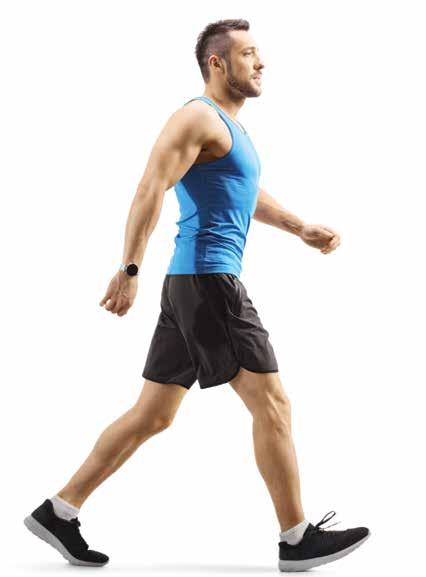
4 minute read
VITAL STEPS
VITAL STEPS The Path to Vascular Fitness
HAPPY, MERRY + ey
Advertisement
FREE 8oz COLD-PRESS WITH PURCHASE OF REGULAR PRICED ITEM
LEXINGTON SQUARE
5230 SUNSET BLVD, STE F LEXINGTON, SC 29072
@CLEANJUICELEXINGTONSQUARE by Marlaina Donato
It is well-known that exercisecombats cardiovascular disease by balancing blood pressure and managing blood sugar, but aerobic exercise, not resistance training, takes the prize for keeping the body’s thousands of miles of blood vessels more supple. A 2017 study published in the journal Medicine & Science in Sports & Exercise shows that all-extremity exercise like brisk walking improves arterial flexibility in older individuals; even those with a sedentary history.
Moving the body regularly also lowers stress hormones like cortisol that can ignite damaging vascular inflammation. A West Virginia University study presented at the 2016 ExperimentalBiology meeting in San Diego showed that aerobic exercise fosters healthy blood vessels in rats exposed to chronic stress. Combining aerobic exercise with good diet and paying attention to triglyceride levels all help to keep us young from the inside-out.


Step It Up According to a 2015 study by the University of Missouri School of Medicine published in Experimental Physiology, walking just 10 minutes after prolonged sitting can restore blood flow in the legs and improve impaired vascular function.
Results like these are another reason to get up and move. Walking, running, swimming, cycling, jumping rope and playing tennis are all excellent options. “For blood vessel flexibility, any sort of sustained aerobic exercise helps. Find something you enjoy so that you’ll keep doing it in the long term,” says Alex Hutchinson, New York Times bestselling author of Which Comes First, Cardio or Weights? Fitness Myths,
Training Truths, and Other Surprising Discoveries from the Science of Exercise. The Toronto-based, Outside magazine science columnist underscores that treadmills and walking outside foster
equal benefits by increasing the heart rate.
The American Heart Association recommends 150 minutes per week of moderate aerobic exercise. Dr. Regina Druz, a board-certified cardiologist and medical director of
the Integrative Cardiology Center
of Long Island, explains, “This translates into 30 minutes a day, five times a week. A specific exercise program may be helpful for those with a medical condition, but for overall vascular health, any physical activity like walking or taking the stairs will do.” Druz also highlights the role of nitric oxide: “One of the most studied mediators of vascular health is [nitric oxide], which makes arteries flexible.”
Research findings published in 2018 in the journal Hypertension spotlight the correlation between the number of daily steps and arterial plasticity through a technique called pulse wave velocity, which measures how fast blood travels from the heart to the feet. The evidence suggests that 1,000 extra steps a day foster significant vascular improvement.
Judy Heller, a walking coach and founder ofWonders of Walking, a fitness program in Portland, Oregon, concurs: “Moving throughout the day, not just once a day, is most important.” Heller is a firm believer in consistency. “My aunt lived to 107 and remained in her three-story house. Her words to me were, ‘Judy, don’t ever stop walking.’ Small changes yield greater rewards over time. We’re meant to move.”
Superfoods and Supplements Nitric oxide, responsible for the dilation and contraction of blood vessels, is produced by exercising and helps to protect the smooth interior lining of the arteries from excessive plaque accumulation. Adding nitric oxide-boosting foods to an already healthy diet can give us an extra edge over vascular conditions like stroke and peripheral artery disease. “Beets, arugula, spinach and rhubarb are all good sources of dietary nitrate. They’re not miracle supplements, but if you make these foods a regular part of your diet, you’ll have a positive effect on your arteries,” says Hutchinson.
Research by Florida State University published in the Journal of the Academy of Nutrition and Dietetics reveals that a one-cup daily serving of blueberries helps to protect the arteries from stiffness. Watermelon, rich in the nonessential amino acid L-citrulline, also packs a nitric oxide punch. Full-spectrum vitamin E is another good option, especially for addressing peripheral artery disease and reducing serum triglyceride levels that are often seen as secondary to “bad” cholesterol levels, but which low levels are vital to cardiovascular health. Druz cautions against using supplements as substitutes for healthy nutrition and exercise, and underscores the importance of dialing down stress, “I advise my patients to build stress resiliency, which involves recognizing and practicing stress response. This, along with nutrition and consistent exercise, will lower inflammation and help build stress resiliency.”
Marlaina Donato is an author and composer. Connect at AutumnEmbersMusic.com.
WE CHANGE LIVES.
Elite Personal Training will help you develop lasting fitness skills for a happier, healthier life! Here, weight loss is more than just exercise – we take a holistic approach, including nutrition, metabolism, stress, and motivation. Our custom fitness programs will help you look better, feel better and be better! We helped change Ramona’s life and want to help change yours.
Call (803) 749-4279 or visit elitepersonaltrainingstudio.com
Meet Ramona Irmo SC
• She dropped 3 pant sizes • Lost 56 pounds • Trimmed 31 inches • ALL IN 6 MONTHS!










